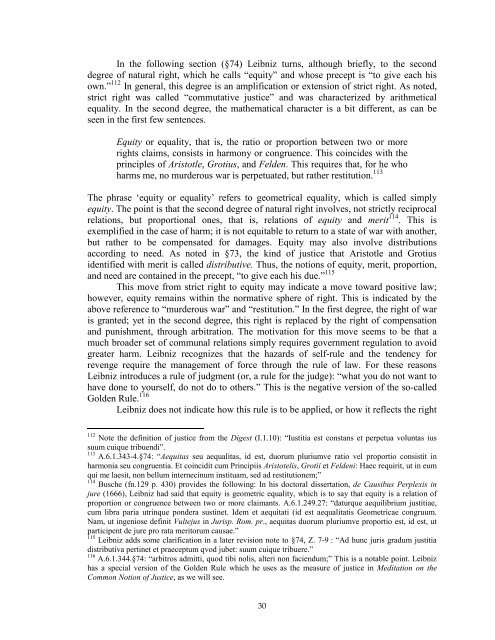Stony Brook University
Stony Brook University
Stony Brook University
You also want an ePaper? Increase the reach of your titles
YUMPU automatically turns print PDFs into web optimized ePapers that Google loves.
In the following section (§74) Leibniz turns, although briefly, to the second<br />
degree of natural right, which he calls “equity” and whose precept is “to give each his<br />
own.” 112 In general, this degree is an amplification or extension of strict right. As noted,<br />
strict right was called “commutative justice” and was characterized by arithmetical<br />
equality. In the second degree, the mathematical character is a bit different, as can be<br />
seen in the first few sentences.<br />
Equity or equality, that is, the ratio or proportion between two or more<br />
rights claims, consists in harmony or congruence. This coincides with the<br />
principles of Aristotle, Grotius, and Felden. This requires that, for he who<br />
harms me, no murderous war is perpetuated, but rather restitution. 113<br />
The phrase ‘equity or equality’ refers to geometrical equality, which is called simply<br />
equity. The point is that the second degree of natural right involves, not strictly reciprocal<br />
relations, but proportional ones, that is, relations of equity and merit 114 . This is<br />
exemplified in the case of harm; it is not equitable to return to a state of war with another,<br />
but rather to be compensated for damages. Equity may also involve distributions<br />
according to need. As noted in §73, the kind of justice that Aristotle and Grotius<br />
identified with merit is called distributive. Thus, the notions of equity, merit, proportion,<br />
and need are contained in the precept, “to give each his due.” 115<br />
This move from strict right to equity may indicate a move toward positive law;<br />
however, equity remains within the normative sphere of right. This is indicated by the<br />
above reference to “murderous war” and “restitution.” In the first degree, the right of war<br />
is granted; yet in the second degree, this right is replaced by the right of compensation<br />
and punishment, through arbitration. The motivation for this move seems to be that a<br />
much broader set of communal relations simply requires government regulation to avoid<br />
greater harm. Leibniz recognizes that the hazards of self-rule and the tendency for<br />
revenge require the management of force through the rule of law. For these reasons<br />
Leibniz introduces a rule of judgment (or, a rule for the judge): “what you do not want to<br />
have done to yourself, do not do to others.” This is the negative version of the so-called<br />
Golden Rule. 116<br />
Leibniz does not indicate how this rule is to be applied, or how it reflects the right<br />
112<br />
Note the definition of justice from the Digest (I.1.10): “Iustitia est constans et perpetua voluntas ius<br />
suum cuique tribuendi”.<br />
113<br />
A.6.1.343-4.§74: “Aequitas seu aequalitas, id est, duorum pluriumve ratio vel proportio consistit in<br />
harmonia seu congruentia. Et coincidit cum Principiis Aristotelis, Grotii et Feldeni: Haec requirit, ut in eum<br />
qui me laesit, non bellum internecinum instituam, sed ad restitutionem;”<br />
114<br />
Busche (fn.129 p. 430) provides the following: In his doctoral dissertation, de Causibus Perplexis in<br />
jure (1666), Leibniz had said that equity is geometric equality, which is to say that equity is a relation of<br />
proportion or congruence between two or more claimants. A.6.1.249.27: “daturque aequilibrium justitiae,<br />
cum libra paria utrinque pondera sustinet. Idem et aequitati (id est aequalitatis Geometricae congruum.<br />
Nam, ut ingeniose definit Vultejus in Jurisp. Rom. pr., aequitas duorum pluriumve proportio est, id est, ut<br />
participent de jure pro rata meritorum causae.”<br />
115<br />
Leibniz adds some clarification in a later revision note to §74, Z. 7-9 : “Ad hunc juris gradum justitia<br />
distributiva pertinet et praeceptum qvod jubet: suum cuique tribuere.”<br />
116<br />
A.6.1.344.§74: “arbitros admitti, quod tibi nolis, alteri non faciendum;” This is a notable point. Leibniz<br />
has a special version of the Golden Rule which he uses as the measure of justice in Meditation on the<br />
Common Notion of Justice, as we will see.<br />
30
















